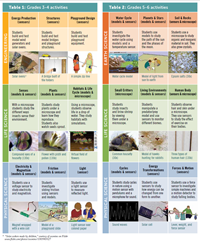Inspiring Young Scientists with Innovative Tools
Do little seeds make little plants? Do big seeds make big plants? Do your feet heat up when you run? Is the inside of my dog’s mouth the same temperature as my sister’s mouth? Do bugs see the same things we do?
The list of questions from young children is virtually endless, unlimited in scope, and free of convention. Kids are curious, which makes them natural scientists. “Start Science Sooner,” a recent Scientific American article1, called for quality science teaching to start earlier in elementary school. But teachers shouldn’t simply supply answers; they need to provide students with the opportunity and tools to explore their own questions.
In the Innovative Technology in Science Inquiry Scale Up (ITSI-SU) project we are excited to add 50 activities for elementary students to our existing collection of over 100 middle and high school activities. The elementary activities will use three computer-based tools:
Models. Students test variables on computer simulations (for example, changing a playground slide’s surface from aluminum to carpet or the slide’s angle from 20° to 40°) and observe what happens.
Probes. Students take measurements — using temperature, motion, voltage, force, and light sensors — and get a hands-on feeling for real-time data collection and the underlying science concepts.
Digital microscope. Students see the world up close. A new, inexpensive digital microscope allows magnification between 30x and 130x — enough to see everything from a bug’s eye to a pollen grain or a growing crystal.
Units for grades 3-4 (Table 1) will include engineering, life science, and physical science, while those for grades 5-6 (Table 2) will focus on earth and space science, life science, and physical science. All activities will be aligned to national science standards.

More teachers, more features, more activities
Funded by the National Science Foundation, ITSI-SU is in the process of scaling up our highly successful ITSI project, bringing even more online activities to teachers and their students. In the first year of the project, ITSI-SU trained 45 middle and high school teachers from Alaska, Iowa, Kansas, and Virginia to use our online activities in their classrooms. Teachers participated in a weeklong face-to-face workshop last summer and two online courses during the school year. They learned how to enroll students in classes and monitor student progress in the online activities. As a signature part of our project, teachers also learned how to customize existing activities, for example, by adding more models or probes or changing questions.
Beginning in the summer of 2011, a second group of teachers — including eight elementary, eight middle school, and eight high school teachers from each of the four collaborating states — will be recruited. We will increase teacher recruitment each year throughout the five-year project.
We recently added new software functionality to the ITSI-SU portal, our online repository of all activities and classes. We are currently enhancing the portal to include more metatags and search functions, plus teacher blog and discussion areas that will encourage peer review for activities customized by teachers.
As exemplary elementary activities emerge from other Concord Consortium research and development projects, ITSI-SU will continue to grow. Our goal remains to enable teachers to use deeply digital activities with their students, engage learners of all ages in scientific inquiry, and monitor their progress. When you teach children to inquire — and give them the tools they need — you create future leaders in science.
1Scientific American Magazine. (2010, February 18). Start science sooner: Excellence in science education must begin in kindergarten.
Carolyn Staudt (cstaudt@concord.org) directs the ITSI-SU project.
Edmund Hazzard (ehazzard@concord.org) is a senior science curriculum developer.
Charles Gale (cgale@his.com) is an independent science curriculum developer.
This material is based upon work supported by the National Science Foundation under grant DRL-0929540. Any opinions, findings, and conclusions or recommendations expressed in this material are those of the author(s) and do not necessarily reflect the views of the National Science Foundation.
